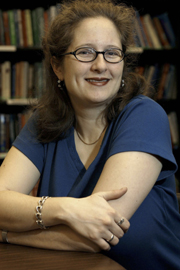|
by Elysia Pitt
Education Professor Helena Osana is beginning to find out what makes working
together such a tough task for graduate students.
Collaborative learning, also known as group learning, is an area that
has received a lot of attention from educational researchers. Over a number
of years, studies with school-age children and undergraduates have shown
that working together is usually beneficial.
However, “group work hasn’t been studied much at the graduate
level,” said Osana, who has worked in the Department of Education
at Concordia for the past two years.
Along with her student, Toby Bennett, Osana looked at graduate students’
perceptions of cooperative learning. They conducted in-depth interviews
with 14 students enrolled in the College of Education at the University
of Missouri.
Their research indicated that contrary to the experience of other students,
group work seems to foster conflict at the graduate level.
According to Osana, many factors contributed to this difference. In addition
to having less time available to them than other students, a specific
kind of leader emerged during group interactions that added to group conflict.
“There was a ‘conceptual leader’ who wanted to have control
and ownership, but at the same time felt that everyone should have the
opportunity to contribute.” This was the major point of conflict
for graduate group projects.
Another frustrating point for most students was the actual structure of
the task they were expected to perform. Without guidance from the instructor,
most students chose to use a labour-saving strategy where the project
was divided so that each student became an expert on a particular area.
“Students rarely had the time, and were rarely encouraged by the
professor, to integrate what they’d learned,” Osana said. Little
opportunity to make connections was another reason graduate students said
they felt dissatisfied.
Proper guidance of graduate group activities is key to successful group
work. Unfortunately, Osana found that few students felt the professor
was actually a part of the group dynamic.
“In most cases, the professor saw himself or herself as the resource.
But in terms of helping the students form their ideas and guide their
interactions, that was absent.
“There is a perception that group work will magically happen among
graduate students,” she continued. But while grad students tend to
have more skills and knowledge than other students, the material they
are expected to master becomes more involved. They need help structuring
and facilitating group work for the activity to be effective.
Osana referred to a jigsaw approach as a possible alternative to a labour-saving
strategy. Each student would learn his or her part well and would then
be expected to teach it to the rest of the group. In this way, a jigsaw
approach would allow group members to learn the whole project better.
This could be extended to the entire class; small groups could take the
responsibility for teaching the entire class about a specific topic.
In addition, Osana argued the professors should make themselves more a
part of the group, and should allocate more class time to group activities.
“Students really wanted to learn from the professor, but they wanted
more demonstration of expertise,” Osana said. She felt that if proper
steps were taken, group study could work well even at the graduate level.
While the students interviewed by Osana and Bennett had varying negative
experiences with collaborative learning, most said that they would use
group work in their own teaching, either at the K-12 or undergraduate
level. They felt that their experience with group dynamics would make
them better facilitators in the future.
Osana’s and Bennett’s research on graduate students is being
revised for publication, but Osana doesn’t plan to stop there. “I
am going to go beyond this perception-based research into what kind of
instruction will work at the graduate level.”
She hopes find out just what can be done to make learning more effective
for graduate students.
|




